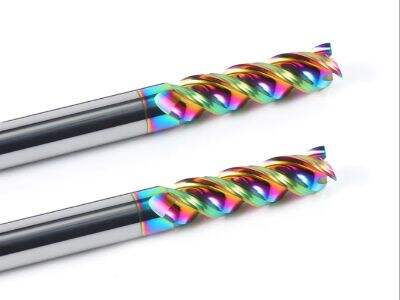Choosing the right tool is essential when you are working on a project that requires you to cut some materials such as wood, metal or plastic. Using the incorrect tool may make your task more difficult and might not yield the results desired. When doing these types of projects, people frequently use a tool known as an end mill. Various Type of Sólido Carburo final Mills Did you know? There are four main types: flat, ball, angle and radius end mills. We will also talk about the differences between them and why knowing about them can help you in your projects.
Fresa plana
First, lets talk about the end mill with a flat end. This endmill by Oucheng has—as its name suggests—a flat bottom edge. This unique shape is especially effective for cutting flat surfaces, which include level and flat plates. Using for example, a flat Carburo final Muíño to machine either the base of a groove or the top of a flat workpiece They are also suitable for straight cuts, like creating the slots and channels. In comparison to other types they have a big cutting surface, which makes them fast material removers. But if you want to start cutting more detailed or complex shapes, you may have to move on to a different type of end mill other than the flat end tool.
Molino de extremo de bolas
Following is the ball end mill. End mills of this type have a bottom shaped edge like a ball (as it has a continuously rounded edge at the bottom). That curvature is why it is great for cutting curves, perros. For instance if you were to be trying to machine the inside of a bowl, a ball end mill would be ideal. Ball end mills are also great for modeling curves and for finishing (ie, smoothing) work. They are made with less cutting surface so can cut very fine use details full when you need to give some highlights to your project. However, you may consider a different type of end mill when it comes to cutting a flat surface.
Angle End Mill
Next up is the angle end mill. This type has its lower edge diagonal or tapered to make an angle. The capability of its unique shape is excellent in cutting angled surfaces, such as the edges of a box or the sides of a piece of material. Besides basic cutting, angle final muíño cortador can also be employed to create chamfers (the edges are cut at an angle and appear beveled) and bevels. The ability for angle end mills to cut at a specific angle means that they can produce very accurate cuts, useful when your work requires precision. If you need a more intricate design for your project, however, it might be time to use a different type of end mill.
Fresa de extremo de radio
Last on the list are the end mills in terms of radius; They will be incredibly helpful in applications where the cutting length is limited. This kind of end mill has a circuit at the top and leaves a curved bottom edge. This is the best for round shape like the surface outside the ball or curvature of a curve edged part. Size wise, radius end mills as well are perfect solution to put fillets (or rounded corners) and radii on a part. Like ball end mills the radius end mills can generate details as well as fine surface finish because its cutter surface area is small. However, if you wish to mill a flat, they you are going to have two select another end mill for the purpose.
Why This Matters and How It Impacts Your Cuts
Therefore, after having gone through this article on the different types of end mills see how they can be a game-changer in your end mill cutting outcomes. Various sorts of end mills will offer you the ability to cut faster or slower and decide the level of granularity of the finish you will be giving your cut. Selecting an undesirable end mill type might set you up for a result that you do not want for your project. This only underscores the need of getting abreast with the various differentiations made between flat, ball, angle and radius end mills. With this, the chance of coming across the right one is the best assurance that your tasks are going to be easier due to the best results within the shortest time.

 EN
EN
 AR
AR
 BG
BG
 HR
HR
 CS
CS
 DA
DA
 NL
NL
 FI
FI
 FR
FR
 DE
DE
 EL
EL
 HI
HI
 IT
IT
 JA
JA
 KO
KO
 NON
NON
 PL
PL
 PT
PT
 RO
RO
 RU
RU
 ES
ES
 SV
SV
 CA
CA
 TL
TL
 IW
IW
 ID
ID
 LV
LV
 LT
LT
 SR
SR
 SK
SK
 SL
SL
 UK
UK
 VI
VI
 SQ
SQ
 ET
ET
 GL
GL
 HU
HU
 MT
MT
 TH
TH
 TR
TR



